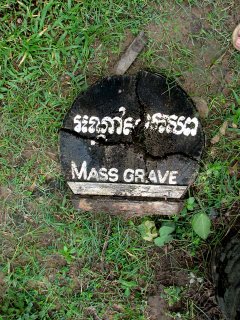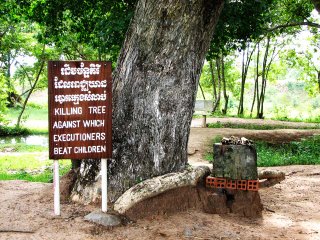Between 1975 and 1979, Tuol Sleng (also known as Security Prison 21 or S21 for short) served as the Khmer Rouge’s main internment camp, “processing” an estimated seventeen to twenty thousand “enemies of the state” during its operation. The high school turned prison presently houses a museum and a small memorial site.
From a cursory glance of the courtyard, it’s hard to imagine any crimes against humanity could have taken place in such a pleasant setting:

The illusion is quickly shattered upon entering the A-Block interrogation building where the bloodied corpses of the prison’s last fourteen victims were found by Vietnamese Liberators, still shackled to the bedposts. The rusted beds, shackles and ammunition boxes (used as makeshift bed pans) still remain, overlooked by photographs taken by the Vietnamese as the rooms were found. Fourteen graves rest a few feet from the building’s entrance.



A frangi pani flower placed near an interrogation room:

B-Block, the next building over, is home to wall upon wall of prisoner mug shots. Comrade
Duch, who oversaw the operation of S21, was meticulous in his documentation of prisoners, carefully taking photographs of everybody passing through the system and coercing them into confessing their nonexistent crimes. A cycle developed whereby prisoners, after being tortured, were forced to name accomplices to their imaginary crimes, implicating more innocents for torture, interrogation and execution.
Hopelessness and terror:

Particularly disturbing amongst the photos, these children were branded as enemies of the state along with their probably innocent parents and suffered the same fates. The ones shown here most likely didn’t survive long enough to see their next birthdays:

Excess photos are haphazardly stored, where they slowly deteriorate over time:

An imposing building fronted by a mesh of barb wire, C-Block holds the prison proper:

Claustrophobic cells line the brick halls:

The view from this barred window probably held little hope for prisoners here:

Prisoner numbers for easier management:

Of the estimated seventeen to twenty thousand Cambodians processed here, only seven are known to have survived.
Day tours in Phnom Penh often include a visit to Tuol Sleng's sister site, the Choeung Ek Killing field which was the last stop for prisoners who didn't succumb to torture at S21. Unfortunately, a heavy rain developed halfway there so we had to turn back to town.
The rain gave way not long after we were back in the city limits so we finished off our tour at a peace statue. The statue is unique in that it's made entirely of melted down guns, including one surrendered by Prime Minister Hun Sen himself.

Nearby is a massive poster of the Cambodian Queen, who looks suspiciously like the British one:

Labels: Cambodia, Death Camp, Phnom Penh, S21, Tuol Sleng


































